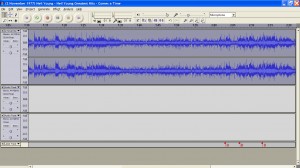by Tina Gasperson
Making multi-track recordings was once the province of those with access to a recording studio, but with the help of a free application called Audacity, anyone with a computer and a microphone can record and edit multi-track audio.
Audacity is an open source audio manipulation application that is easy to download and install. Follow the on-screen instructions, and then launch the application. To begin recording, plug a microphone into your computer or check to see if your computer has a built-in microphone and use that. Recording with a microphone is the default state in Audacity, so click the record button and begin speaking or singing. If everything is working as it should you’ll see the level indicators moving. When you’re done recording this first track, play it back to make sure it is the way you want it to be, then save it as a new project by clicking on File, then Save Project As. Give it a name and click Save.
To add a new track, with your new project file open, click on Project, then New Audio Track. A new space for the track will appear underneath the track you just recorded. Now, when you click record, the original track will play while at the same time recording your new track. This makes it easy to sing along in harmony or unison, or to play an instrument to accompany your singing. Save this track, and start a new one. Now you can add more voices, a percussion track, or a new instrument, either by playing the instrument into the microphone, or by plugging your electric instrument into the computer. For example, if you have an electric guitar with a 1/4″ connection, you can purchase a 1/4″ to 3.5mm adapter, plug the guitar into the computer’s microphone jack, and record your guitar using the method described above.
When you’re all done with your new multi-track recording, you can export it as a .WAV or .MP3 file and share it with the world.
Tina Gasperson (tinahdee@gmail.com), affectionately known as Computer Lady by her family, has been writing about IT, home computing, and the Internet for more than a decade.

{ 3 comments }
Thanks for your help, but this approach doesn’t solve a problem when multitracking with audacity: the new track you are recording picks up the backing track too!
This is effectively ‘bouncing’ tracks, something you do when if you run out of empty tracks, you can do to free up some space. The difference is when you ‘bounce’ tracks you can pan them left and right to preserve the individual track somewhat. Audacity seems to bleed the sound into any track you are recording.
What should be pointed out is that, with the right hardware (i.e. A good M-Audio sound card) Audacity SHOULD be able to record using ‘software playthrough’ on the preferences menu. Unfortunately this is not the case for me right now.
I’ve posted my problem on ‘multitracking audio using Audacity’ on the Audacity forums
(http://forum.audacityteam.org/viewtopic.php?f=12&t=11391).
If anybody has a solution without purchasing a soundcard, please let me know!
Thanks in advance.
Wrong title. Please revise.
This is not multitrack recording. This is adding a track one by one and then multitrack editing and mixing.
It is extremely important that thhe photographer you choose for your wedding uses a contract.
Naturally, wedding photography started to borrow this look and start demanding the grainy black and white look.
If your wexding portfolio is in need of some attention this iss the seminar foor you.
Comments on this entry are closed.